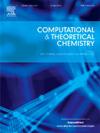Computational study on thiolated and functionalized graphene oxide for heavy metal recovery
IF 3
3区 化学
Q3 CHEMISTRY, PHYSICAL
引用次数: 0
Abstract
The escalating use of heavy metals in industrial, agricultural, and medical applications has amplified pollution challenges, necessitating innovative remediation strategies. This study investigates the potential of a hybrid graphene oxide/thiolated-poly(N-isopropylacrylamide) (GO/GOSH@PNM) system for the reversible, temperature-dependent removal of heavy metals, specifically Pd(II), Pb(II), and Cd(II), from aqueous environments. Molecular dynamics (MD) simulations reveal that below the lower critical solution temperature (LCST) of 32 °C, the PNM polymer adopts a hydrophilic coil configuration, enabling efficient coordination of metal cations via hydroxyl, thiol, and amide oxygen functional groups. Density functional theory (DFT) calculations corroborate these findings, highlighting favorable adsorption free energies and strong interactions between the polymer and metal ions at lower temperatures. Above 32 °C, the polymer transitions to a hydrophobic globular conformation, reducing cation affinity and facilitating their release. This temperature-induced binding and release mechanism allows for heavy metal recovery and the regeneration of the hybrid system. The GO surface demonstrates higher polymer affinity than the GOSH surface, likely due to its increased hydroxyl group density. These findings underline the potential of the GO/GOSH@PNM system for sustainable and efficient heavy metal remediation, with further optimization promising enhanced performance.

重金属在工业、农业和医疗应用中的使用不断增加,加剧了污染挑战,因此需要创新的修复策略。本研究探讨了氧化石墨烯/硫醇化聚(N-异丙基丙烯酰胺)(GO/GOSH@PNM)混合系统在从水环境中可逆地、随温度变化地去除重金属(特别是钯(II)、铅(II)和镉(II))方面的潜力。分子动力学(MD)模拟显示,在 32 °C 的较低临界溶液温度(LCST)以下,PNM 聚合物采用亲水线圈构型,通过羟基、硫醇和酰胺氧官能团有效配位金属阳离子。密度泛函理论(DFT)计算证实了这些发现,强调了聚合物与金属离子在较低温度下的有利吸附自由能和强烈的相互作用。温度高于 32 ℃ 时,聚合物会转变为疏水的球状构象,从而降低阳离子的亲和力并促进阳离子的释放。这种温度诱导的结合和释放机制使重金属得以回收,混合系统得以再生。与 GOSH 表面相比,GO 表面具有更高的聚合物亲和力,这可能是由于其羟基密度增加所致。这些发现强调了 GO/GOSH@PNM 系统在可持续和高效重金属修复方面的潜力,进一步优化有望提高其性能。
本文章由计算机程序翻译,如有差异,请以英文原文为准。
求助全文
约1分钟内获得全文
求助全文
来源期刊

Computational and Theoretical Chemistry
CHEMISTRY, PHYSICAL-
CiteScore
4.20
自引率
10.70%
发文量
331
审稿时长
31 days
期刊介绍:
Computational and Theoretical Chemistry publishes high quality, original reports of significance in computational and theoretical chemistry including those that deal with problems of structure, properties, energetics, weak interactions, reaction mechanisms, catalysis, and reaction rates involving atoms, molecules, clusters, surfaces, and bulk matter.
 求助内容:
求助内容: 应助结果提醒方式:
应助结果提醒方式:


